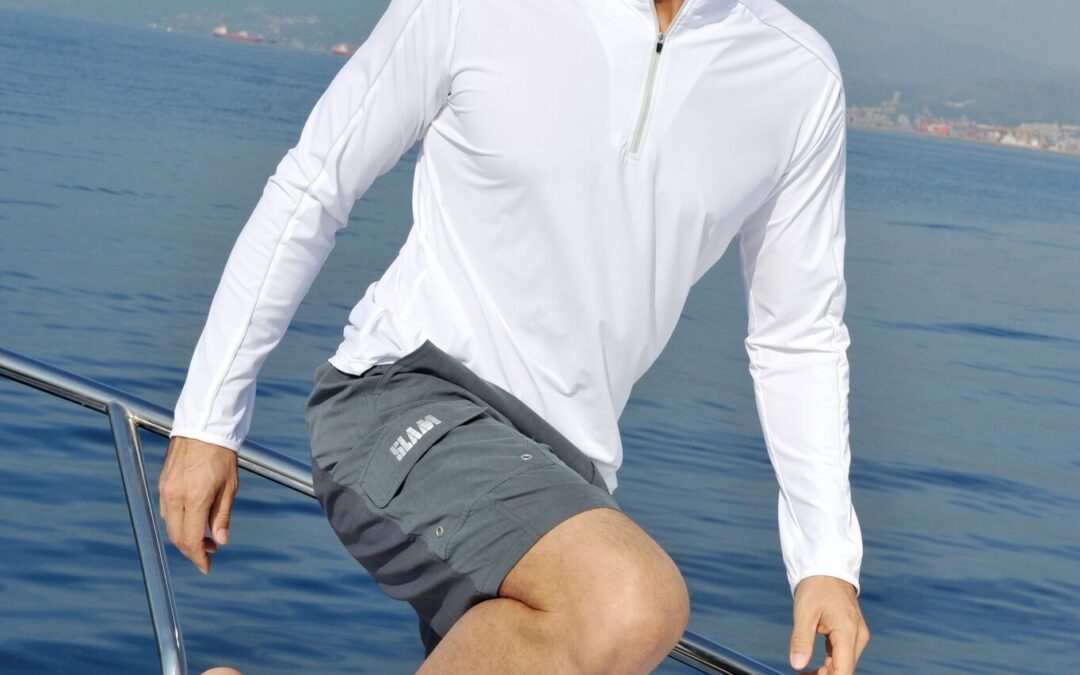As the season blazes on, there’s one group who will be feeling the heat even more than most: the crew. Whether dealing with cramped sleeping conditions, serving the latest guest demands or arranging the next water sports excursion, crew can have a tough time despite the luxurious nature of the yacht world. Hope can be found in the new developments in crew uniform. New design technology means that crew can explore cooler clothing options whilst still maintaining the professionality standards that guests expect to see. We got insights from Mallorca Clothing, Taylor Made Designs and Deckers, to bring you the latest in uniform tech.
Modern requirements
Carla Poole, Marketing Manager at Taylor Made Designs (TMD), says that the most significant change in design technology she has noticed is the change in fabrics that buyers are requesting. She explains how the traditional preference was for 100% cotton due to cotton’s ability to hold colour and the professional look of the clothing. However, in the last two years, the company has seen a great rise in polycotton – a combination of 35% cotton and 65% polyester. “Polycotton helps any sweat or moisture dry out quicker, due to its small air pockets. We now recommend it to all companies, and brands have been taking note,” she said. Taylor Made Designs has seen most everyday garments such as softshell jackets have become lighter, responding to demand from crew. Poole said: “Dresses are coming more modern, replicating high-street style. They are made thinner but with more elastane, so they fit and move well.”
Deckers Sales Director Kate Greaves has also noticed a rise in requests for fabrics designed to withstand heavy wear and tear, as well as to provide quality and comfort.?Like Poole, she commented on one crucial ingredient. She said: “The majority of technical fabrics have polyester content which caters [especially well to superyacht] Regatta crew, as the anti-wicking fabric acts most effectively when airflow is prominent.” Deckers has found that beyond the traditional polo shirts, quick-drying shorts and skorts are highly sought after, and requests for rash guards, board shorts and sunhats containing UV protection are increasingly in high demand.?

Hot new products & brands
Mirko Rastig, Owner & Director at Mallorca Clothing, says that he has been given a fantastic feedback by the company’s customers (both superyacht and smaller private vessels) about a new?Aquatech polo from innovative clothing design business Line 7. The anti-microbial fabric is quick dry and has a UBF rating of 50+UV, keeping crew not only cool but protected from sun damage in the hot summer months.
Deckers has received a positive response on its technical deck trainers, where brands such as Adidas have introduced a modern take on deck shoes as part of their Sailing Collection.? Adidas’ Deck Trainer, for instance, has been a top seller since last Season, and with current trends steering towards a sporty style, and not so much the classic boat shoe, the SWIMS brand has also made its mark in the superyacht circuit.
Both Deckers and Taylor Made Designs (TMD) report big brands like Musto, Slam, Gill Marine to be pioneering in their development of new technologies. However, cheaper and lesser-known brands have also now cottoned onto the high demand in technical fabrics, meaning cooler fabrics are more accessible for lower budgets. Poole said: “Stormtech is one brand that I see as true pioneers. They test all their garments extensively, putting them through their paces in all conditions. They also pay great attention to every detail meaning that every little feature is carefully tailored to the wearer, and considering this they are very reasonably priced.”

High-level innovation
Line 7 has developed what it calls celiant technology – fabric that is said to reflect energy back into the body, meaning the wearer feels boosted and re-energised. The company’s website explains the technology behind it, saying: “This radical, proprietary fibre is suffused with a potent mix of thermo-reactive minerals that recycle and convert radiant body heat into infrared energy. A medically proven vasodilator, infrared energy is the grail of the high-action pioneer: stimulating circulation, enhancing cellular recovery and regulating body temperature.”Though developed for high-action sportswear, we can also see this being very useful for hot and tired crew.
Deckers has revealed it is currently in talks with a fabric supplier that implant a tiny chip within a garment, recording the life of the clothing. ?With the data the chip collects, the company will then be able to monitor how much exposure to UV an item has endured, how hot it has been washed and dried, and even how many times it has been through a cleaning cycle. This will help its designers in further development of the most suitable fabrics for the superyacht industry, as well as giving valuable feedback as to why an item may have shrunk or lost colour. Responding to growing demand for bespoke crew uniform, Deckers is also developing its own technical range. It is currently trialling a range of different fabrics, to make sure products will do the job well and remain available year on year.
Where previously image printing onto garments left them feeling stiff and heavy, Taylor Made Designs now offers Dye Sublimation – a printing process whereby specialist machines take the image and use a combination of pressure and high temperatures to transfer it and make it part of the fabric. The result is a high-quality photographic design featured on the uniform, with a lot less sweat for the wearer than traditional image-printed clothing. Only available on polyester, this technology is said to be gaining more popularity in the superyacht industry as some owners move away from more traditional designs.

Future uniform developments
With superyacht crew facing ever-changing itineraries and constant transition between shifting worldwide climates, clothing has had to step up a gear to compete with the everyday challenges faced onboard. As the market continues to adapt accordingly, we hope that crew will feel the benefits of this new technology.

